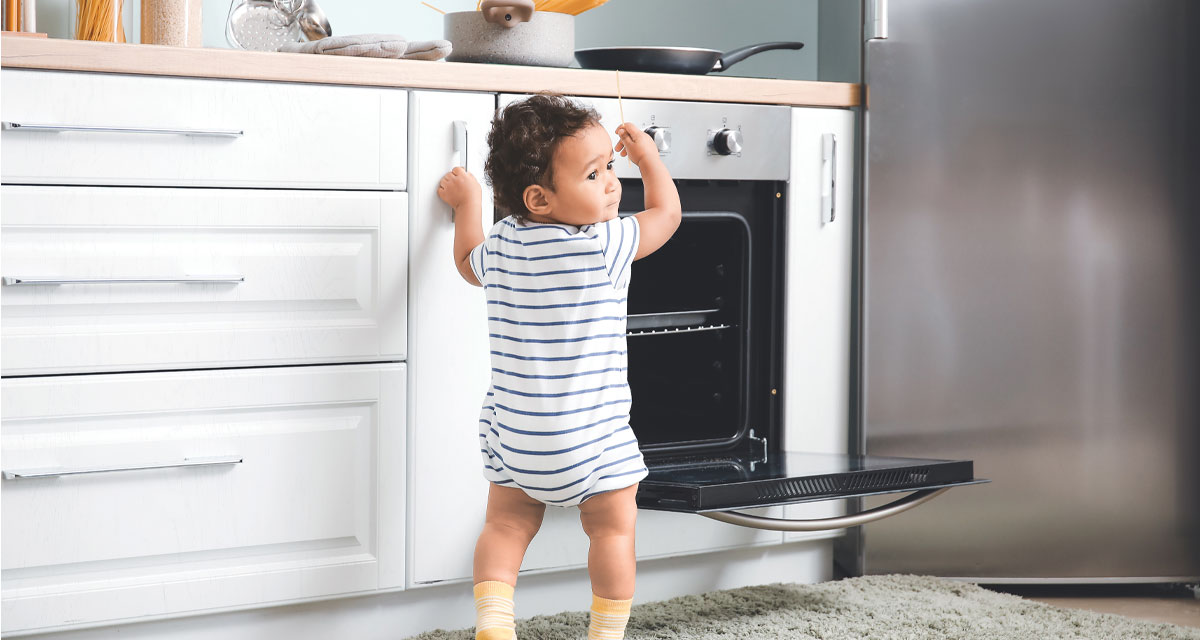Each month this series will provide important facts and tips surrounding child safety in an effort to support parents and caregivers as they navigate reducing risks and creating the safest environment possible for the children in their lives.
You can have a playroom filled to the brim with toys, and children will find the one item that was never meant to be played with. The truth is, children are drawn to the things in your home that they aren’t supposed to touch or consume because of their curious nature. “Wow, I wonder what that does!” he or she thinks. While innocence and curiosity are a beautiful part of childhood, they also breed the opportunity for accidents and injuries inside your home. In honor of Child Safety Month, let’s explore common household dangers, how to avoid accidents from happening and what to do if an accident should occur.
Understanding Common Household Dangers
A sobering statistic from KidsHealth.org states that “More than a third of child injuries and deaths happen at home.” This isn’t shared to scare you, but to echo the importance of being aware of what possible risks are in your home so you can create a plan to avoid them.
According to the CDC (Center for Disease Control) the most frequent areas with the highest possibility for injury in the home occur where there is/are:
- Water: in bathrooms, kitchens, swimming pools, hot tubs and outdoor bodies of water.
- Extreme heat and fire: in the kitchen, in the fireplace or at a barbeque grill.
- Toxic substances: bathroom cabinets, under-sink storage, medicine and first aid storage, outdoor sheds and garage areas.
- Risk of falling: stairs, windows, rugs, clutter creating tripping hazards.
- Choking hazards: unattended mealtime areas, drawers and storage containing small parts such, as batteries, coins, etc.
Reducing Risk of Household Injuries
Childproofing your home is the best way to protect your kids from accidents and give you peace of mind. Remember, no amount of childproofing is better than intentional supervision over the children in your home; moreover, that also serves as an additional barrier to keep them safe. While lots of parents and guardians put forth effort in child proofing around the baby and toddler periods of childhood, it is important to continue taking inventory of high-risk areas for older children as well.
Add safety devices around your home to ensure children cannot access harmful substances and dangerous zones of the house. Here are a few simple childproofing steps and devices to consider to protect the kids in your home:
- Outlet covers to avoid electrocution and putting power strips and plugs out of reach;
- Safety latches for all cabinets, drawers and storage areas to reduce risk of ingestion or choking;
- Corner bumpers to eliminate sharp edges of tables and other furniture that can lead to head, eye and other bodily harm;
- Knob covers to stop children from opening doors they should not enter without supervision;
- Baby gates at entrances and exits that lead to areas where children should not be alone, especially if water is present on the other side;
- Shortened cords for blinds and other area to eliminate strangulation risk;
- Furniture and appliance anchors to keep heavy pieces from falling on kids;
- Safes for guns and other weapons to keep them out of reach of children;
- Locked toy storage for small-part toys older children may have that pose choking risks for younger children;
- Smoke detectors and carbon monoxide detectors in the event there is a fire or gas leak.
Creating Intentional Safety Habits in Your Home
Your home is where your children will spend most of their time the first few years of their life, and feel safe and find comfort when being there. As caretakers, it’s important to create intentional safety habits the whole family can follow with the goal to keep that safe and comfortable feeling intact long-term.
Here are a few simple ways to get started:
- Have adults and teens complete a CPR and first aid course to help build confidence and skills should you need them.
- If you see something, say something. Even if you think another adult doesn’t need to be reminded about a safety risk, say it anyway.
- Set supervision guidelines for both adults to ensure, and children to understand safety.
- Always check that access points are shut off to household dangers.
- Dispose of hazardous and questionable substances and items properly.
- Get in the habit of closing baby gates and safety latched items, even when kids aren’t present to build muscle memory.
Establishing a Plan if Injury Occurs
Anyone who has ever been through a freak accident or serious injury can tell you the importance of having a plan prior to actually needing it. Human beings’ “flight or fight” response is triggered when trauma occurs, and you never know which kind you will experience until you are in the moment. Having a reactive safety plan in the event that your child (or any family member) experiences an emergency, can sometimes make the difference between life or death.
Here are a few suggestions on how to create your family’s safety response plan:
- Keep all emergency contact phone numbers in the cellphone of each parent, guardian and caretaker, as well as in an easily visible place in the house.
- List any and all medications family members are taking long-term and have them ready to grab or view on a smart device to easily provide for EMTs or doctors.
- Prepare a “go bag” with changes of clothes and diapers in children’s current sizes, as well as first aid supplies and important documents that can easily be taken with you should you need to leave in a hurry for the hospital.
- Establish and practice a fire escape plan twice per year with a focus on making sure young children understand the different ways to exit the house safely.
- Discuss the possibility of being an emergency contact for your family and/or close friends, should you need to have them be contacted or to lean on if something happens.
Remember, Always Better Safe Than Sorry
Despite every avoidance, sometimes unfortunate accidents can still occur. If you see a child directly experience a safety hazard or injury, or suspect something has happened even if you did not witness it, it’s always better to get it checked out. Depending on the severity of what has happened, you’ll want to contact your child’s pediatrician immediately or head to your closest Emergency Room. If your child has experienced a true emergency, call 911 immediately to get an ambulance on the way.
Helpful Resources to Learn More
- CDC Centers for Disease Control – Child Safety & Injury Prevention Resources {ONLINE ARTICLE HYPERLINK: https://www.cdc.gov/safechild/index.html}
- Safe Kids Worldwide {ONLINE ARTICLE HYPERLINK:https://www.safekids.org/}
- www.PreventChildInjury.com {ONLINE ARTICLE HYPERLINK:}























